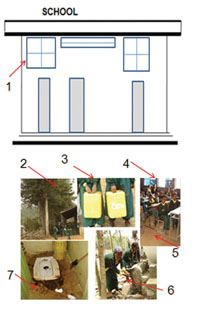Self-Assessment Questions (SAQs) for Study Session 5
Now that you have completed this study session, you can assess how well you have achieved its Learning Outcomes by answering these questions. Write your answers in your Study Diary and discuss them with your Tutor at the next Study Support Meeting. You can check your answers with the Notes on the Self-Assessment Questions at the end of this Module.
SAQ 5.1 (tests Learning Outcome 5.1)
You have visited one of the schools in your locality and drawn the diagram of the front view of the main building shown in Figure 5.5. You also inspected the facilities and took the photographs below. What parts of this building and its surroundings can you see that satisfy the criteria for physiological satisfaction, disease prevention and accident prevention? List the parts of the building and its surroundings using the numbers shown, and state why they are important.
Answer
| Criteria | Parts of the school building |
|---|---|
| Physiological satisfaction | 1 Window: facilitates good vision and ventilation 5 Smooth cleanable floor: avoids dust and vector breeding 4 Proper chairs and tables: facilitates proper sitting position |
| Disease prevention | 3 Water: for drinking and handwashing for personal hygiene 6 Handwashing facility: for personal hygiene 7 Presence of latrine: for personal hygiene |
| Accident prevention | 2 Tidy compound: no bushes that could harbour snakes and rats |
SAQ 5.2 (tests Learning Outcome 5.2)
Go around your kebele and list the categories and number of public institutions that require your service.
Answer
Your list may include kindergartens, 1st and 2nd cycle schools, junior high school, Health Posts, private clinics, mill house, or possibly others.
SAQ 5.3 (tests Learning Outcome 5.3)
You have learned about healthful housing in Study Session 4. What basic hygiene requirements are shared between healthful housing and institutional hygiene?
Answer
The health development of individuals, whether at home or in schools, prisons or other institutions, shares common needs. These are ensuring the physiological satisfaction, disease and accident prevention, and the psycho-social (mental) satisfaction in terms of the provision of basic hygiene and sanitation.
SAQ 5.4 (tests Learning Outcome 5.4)
The local kebele leader on the behalf of the woreda administrative office was asked to provide a licence for a private primary school. The kebele leader asks you to assist him to describe the basic hygiene requirements of an elementary school. What would you tell him?
Answer
The basic hygienic requirements of a school include: school compound cleanliness, proper solid waste management, access to safe and adequate water supply, access to adequate latrine provisions, classroom cleanliness, adequate lighting and ventilation, free from any external hazard such as noise, accident and pollution.
SAQ 5.5 (tests Learning Outcome 5.5)
You have to make a plan of action for the forthcoming year for the promotion of institutional hygiene. Briefly describe the activities that need to be included in your plan.
Answer
Firstly, identify the number, type and location of the various different institutions in the kebele. Then, plan a schedule for visits and inspections of each institution in the coming year. This will require the preparation of checklists and arrangement with the heads of the institutions concerned. The visits are followed by writing and delivering feedback reports and discussing the findings with the relevant authorities. Finally, you should decide on possible follow-up activities such as meetings, hygiene education, mobilising resources, etc.
SAQ 5.6 (tests Learning Outcome 5.6)
There is a school in your kebele that is due for an inspection of its hygiene and sanitation status. What tools of inspection will you consider using?
Answer
The inspection tools would include a checklist on which to note physical observations of the various aspects of the school environment. It could also be useful to interview the students and teachers, and possibly use a questionnaire if a more thorough survey of personal hygiene was required.
Summary of Study Session 5

